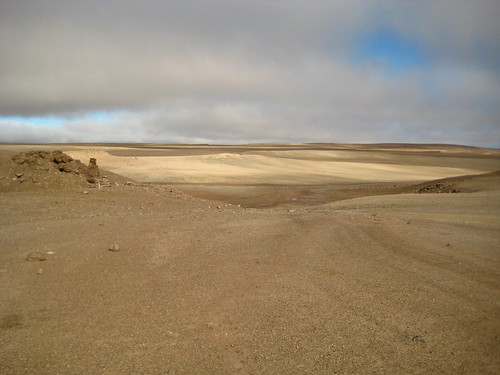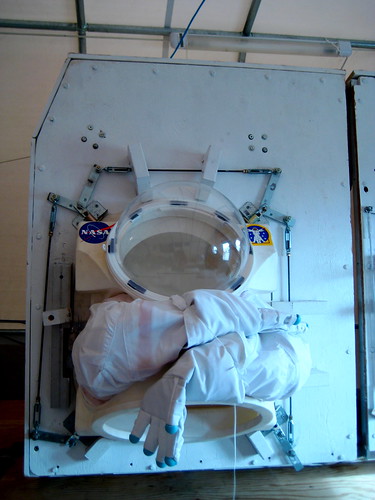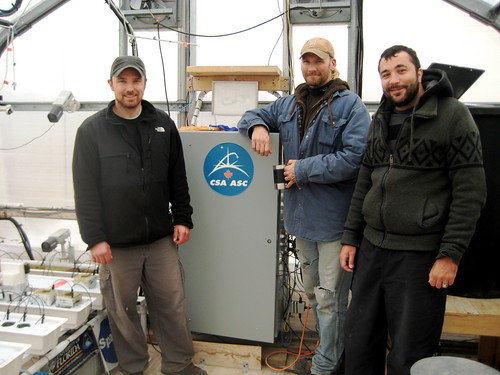NASA is inviting the public to choose an area in northern Arizona where explorers will conduct part of the annual Desert
Research and Technology Studies, known as Desert RATS.
“Desert RATS is an annual test where NASA takes equipment and crews into the field to simulate future planetary exploration missions,” said Joe Kosmo, Desert RATS manager at NASA’s Johnson Space Center in Houston. “We want the public to be a part of this.”
From July 27 through Aug. 8, space enthusiasts can vote where to send the Desert RATS team, which includes engineers, scientists and astronauts. To cast your vote, visit:
http://desertrats2010.arc.nasa.gov
The website features interactive panoramic images of lava, rocks and desert for the public to choose as the most interesting destination to explore. The location that receives the most votes will be announced Aug. 16. Astronauts
will visit that site to perform field geology and collect rock samples.
The Intelligent Robotics Group (IRG) at NASA’s Ames Research Center at Moffett Field, Calif., took the panoramic images of terrain and geologic features in early 2009 at Black Point Lava Flow in Arizona.
“It is essential to involve the public in NASA’s exploration program to engage and inspire the next generation of scientists and engineers,” said IRG Director Terry Fong. “We want people of all ages to be able to actively participate, contribute and collaborate in meaningful ways to NASA’s activities.”
The Desert Rats 2010 mission also involves field testing two space exploration vehicles, which could allow astronauts to spend two or more weeks living, working, and traveling across different planets. Astronauts will use two such vehicles to explore a lava flow and test data collection methods, communications protocols, mission operations, and advanced technology. Desert RATS is sponsored by NASA’s Exploration Systems Mission Directorate in Washington.
For more information about Desert RATS, visit:
https://www.nasa.gov/desertrats
For more information about NASA and agency programs, visit:
https://www.nasa.gov
Month: July 2010
Byron Adams (ASU): K10 Experiment and other Research
Video by Elaine Walker (EPO, HMP, Mars Institute)
Copyright 2010 Mars Institute
This blog is courtesy of Haughton Mars Project (HMP)
For more information please visit www.marsonearth.org
Byron Adams is a fourth year Ph.D. candidate at the Arizona State University School of Earth and Space Exploration. His primary research focuses on utilizing thermochronology, cosmogenic radionuclide dating, and structural and geomorphological mapping to study the tectonic history and geomorphology of the Bhutan Himalaya. He is advised by Kip Hodges, Kelin Whipple and Arjun Heimsath.
Byron has a B.S. in Geology from Ball State University in Indiana and a M.S. in Geology from the University of Cincinnati in Ohio. While at Cincinnati, he worked in the Lahul Himalaya of northern India investigating exhumation and river incision rates with Craig Dietsch and Lewis Owen.
Kelsey Young (ASU): K10 Experiment and other Research
Video by Elaine Walker (EPO, HMP, Mars Institute)
Copyright 2010 Mars Institute
This blog is courtesy of Haughton Mars Project (HMP)
For more information please visit www.marsonearth.org
Kelsey Young is a geologist in the School of Earth and Space Exploration at Arizona State University. Kelsey earned her undergraduate degree in geology from the University of Notre Dame where she studied Earth-based analogs for Mars. Specifically, she conducted fieldwork to study the interactions of lava and water in conjunction with examining similar features on the surface of Mars. While completing this work, she became interested in using terrestrial analogs to work on issues associated with manned space exploration. Kelsey is now working on her Ph.D. in geology, and is pursuing this interest by combining geology with the logistics of planetary surface exploration.
Working in terrestrial analog sites like Haughton Mars Project gives her first-hand experience on active processes happening on other planetary surfaces. While at HMP- 2010, Kelsey will be collecting impact breccia samples from inside the crater in order to date the age of the impact using (U-Th)/He thermochronology.
Kelsey is currently working under one of NASA’s Graduate Student Researcher Program’s (GSRP) Fellowships, so she is working closely with NASA Johnson Space Center on incorporating a spectrometer into the Desert RATS field test (another analog test run by NASA). She will be supporting D-RATS as both a member of the sciencebackroom, and as one of four geologist crewmembers for the test.
———–
Kelsey Young
School of Earth and Space Exploration
Arizona State University
Dr Matthew Deans (NASA Ames): K10 Robot Experiment
Video by Elaine Walker (EPO, HMP, Mars Institute)
Copyright 2010 Mars Institute
This blog is courtesy of Haughton Mars Project (HMP)
For more information please visit www.marsonearth.org
Dr Matthew Deans is the Deputy Group Lead of the Intelligent Robotics Group (IRG), in the Intelligent Systems Division (Code TI), at NASA Ames Research Center. He has significant experience in Field Robotics, participating in field experiments in Antarctica, the Arctic, Atacama Desert, Canadian Rockies, and several sites in the continental US. He was the field team lead for the K10 test at Haughton Crater, Nunavut Canada, in July 2007 and again in July 2010. The K10 experiment is looking at how to use robots to augment human space exploration. The K10 will follow up on field work done by humans by adding additional surveys, context imaging, 3-dimensional scanning, and in situ analytical instruments. These measurements will complement and extend the investigations that were started by field geologists last year.
HMP 2010: Several New Arrivals – HMP Activity Picks Up
This blog is courtesy of Haughton Mars Project (HMP)
For more information please visit www.marsonearth.org
 |
| copyright 2010 Mars Institute |
The K10 team from NASA Ames, Dr Trey Smith, Susan Lee, Vinh To, Eric Park and Dr Hans Utz, led by Dr Matthew Dean, scouted the site B location and made some upgrades to prepare the robot for more follow up missions.
The Hamilton Sundstrand team, Ron Sidgreaves and Todd Glazier, finalized and assemble the suit ports and stairs on the Mars-1 Humvee Rover. They fitted the suit and stairs for the geologist, Kelsey Young, who will be conducting EVAs in the suit. Kelsey is a Ph.D. candidate at Arizona State University, in the School of Earth and Space Exploration.
There were several new arrivals today, including Kira Lorber of the Mars Institute. Kira is the HMP Logistics Manager for the Mars Institute and typically works out of Resolute Bay during the HMP seasons. She has just had her first meal at camp!
Two of Star’s uncles, Paul Amarualik and Joe Amarualik (former HMP deputy base camp manager) flew in and stayed part of the day before departing again. Dr Brian Glass’s sister, Vicky Glass, has arrived. She is a fire chief in Atlanta will be our safety officer this season and will working with Dr Valerie Myers (NASA JSC) on her immunology study.
Other new arrivals were Dr Perry Johnson-Green and Lauren Artman, both ecologists from CSA, Steve Hoffman (NASA JSC), Tiffany Montague (Google), Dr Stephen Braham (Chief Field Engineer and Associate Director, HMP / SFU), and Stephen’s assistants, Vik Kumar, Parna Niksirat and Isaiah Mandryk.
Nathan Kalluk and Star Amarualik flew back to their home town of Resolute Bay. We thank them for all of their hard work this season!
HMP 2010: K10 Team Analyzes Data – CRUX Team Begins Setup
This blog is courtesy of Haughton Mars Project (HMP)
For more information please visit www.marsonearth.org
 |
| copyright 2010 Mars Institute |
The K10 team from NASA Ames, Dr Trey Smith, Susan Lee, Vinh To, Eric Park and Dr Hans Utz, led by Dr Matthew Dean, finished up at locale 8 on Von Braun Planitia, sending back data from the instruments, including a gigapan camera, LiDAR, microscopic imager, ground penetrating radar and an x-ray fluorescence spectrometer. Byron Adams and Kelsey Young analyzed the data. They are both Ph.D. candidates at ASU in the School of Earth and Space Exploration. All of Dr Mark Helper’s objectives for robotic follow up were met at locale 8. Dr Helper is a Distinguished Senior Lecturer at the University of Texas at Austin.
The CRUX Drill team, led by Dr Brian Glass (Senior Scientist, Drilling Automation, NASA Ames), transfered and positioned a load of gear to a location near the drill site in the morning, and went out again after dinner to set up the drill tent and other equipment.
HMP 2010: First K10 Robot Field Tests – Dr Brian Glass's 50th Birthday!
This blog is courtesy of Haughton Mars Project (HMP)
For more information please visit www.marsonearth.org
 |
| copyright 2010 Mars Institute |
The K10 team from NASA Ames, Dr Trey Smith, Susan Lee, Vinh To, Eric Park and Dr Hans Utz, led by Dr Matthew Dean, drove the robot out to Von Braun Planitia. Thanks go to our camp chef, Jeff Fagen, for organizing lunch shifts for the K10 team so that they could work continuously.
The Hamilton Sundstrand team, Ron Sidgreaves and Todd Glazier, began installing the suit ports into the Mars-1 Humvee Rover. Thanks to Jesse Weaver and Travis Oaks (technicians) for helping.
After dinner, we celebrated Dr Brian Glass’s 50th birthday! Dr Brian, from NASA Ames, was first involved with the HMP in 1998 and has not had a birthday at home since that year. Dr Brian’s birthday has become somewhat of a mid-season ritual, which usually occurs at the peak of the season. He began work at HMP doing wireless communications for field science, and research with rovers, and in the last 5 or 6 years has focused on automated drills. This season he is continuing testing with the the CRUX (Construction Resource Utilization Explorer) Drill.
HMP 2010: Traverse to Wyle Hill and Other HMP Activities
This blog is courtesy of Haughton Mars Project (HMP)
For more information please visit www.marsonearth.org
July 21 Flickr Photo Set
 |
| copyright 2010 Mars Institute |
Today was overcast with no precipitation.
Byron Adams and Kelsey Young, both in the Geology Department at ASU, traversed to Wyle Hill above Trinity Lake and collected samples of impact breccia. This is research they are doing in addition to working with the K10 robot team.
The K10 team from NASA Ames, Dr Trey Smith, Susan Lee, Vinh To, Eric Park and Dr Hans Utz, led by Dr Matthew Dean, set up a repeater at location 8 on Von Braun Planitia and have their robot nearly ready for testing.
The CRUX (Construction Resource Utilization Explorer) Drill team, Dr Brian Glass (Senior Scientist, Drilling Automation, NASA Ames), Dr Sarah Thompson (NASA Ames), Shannon Statham (Georgia Tech, Ph.D. student) and Mateusz Szczesiak (Honeybee Robotics), successfully tested their communication systems, scouted for locations and picked out a drilling site.
Thanks to Ben Audlaluk (from Grise Fiord) for supporting the traverses, and to Jesse Weaver (mechanic) and his assistant, Travis Oaks, for keeping the Kawasaki bikes in tip top shape.
Ron Sidgreaves and Todd Glazier, both of Hamilton Sundstrand, have the two suit ports well underway. They will be installing them on the back of the Mars-1 Humvee Rover tomorrow.
HMP 2010: CRUX Drill Team Arrives, Greenhouse Team Departs
This blog is courtesy of Haughton Mars Project (HMP)
For more information please visit www.marsonearth.com
July 20 Flickr Photo Set
 |
| copyright 2010 Mars Institute |
The K10 Robot team from NASA Ames, led by Dr Matthew Deans and including Dr Trey Smith, Susan Lee, Vinh To, Eric Park and Dr Hans Utz, tested instruments and components and traversed with the robot during a break in the weather. Kelsey Young and Byron Adams (both PhD students in the Geology Dept. at ASU) did traverse planning for this year’s follow-up mission. The robot team will program the traverse coordinates into the robot accordingly.
The Arthur Clarke Mars Greenhouse team, Matt Bamsey (CSA), Talal Abboud (CSA) and Thomas Graham (Univ. of Guelph) wrapped up and packed and will be monitoring the greenhouse remotely until next HMP season. They departed this evening, along with Drs Robert Ferl and Anna-Lisa Paul (both faculty at the University of Florida).
The rest of the CRUX drill team: Dr Brian Glass (Senior Scientist, Drilling Automation, NASA Ames), Dr Sarah Thompson (NASA Ames) and Shannon Statham (Georgia Tech, Ph.D. student), arrived on Devon Island this evening. They reunited with their fourth team member, Mateusz Szczesiak (Honeybee Robotics), who has been at the HMP Research Station running tests as part of his research for Honeybee.
A helo flight to prepare for next year

On the way back from Kelly Lake, we swung by Pavilion Lake to take some shots of the live sub operations underway. This is a very beautiful part of the world.
Next year the team will be diving into a lake called Kelly Lake, and potentially Pavilion Lake at the same time. This creates a challenge for the communications team. Both sites must have broadband access to the Space Network Research Federation (SNRF) and the Internet, and be able to communicate from site to site at all times.
Satellite connectivity is great, but in this environment the “terrain mask” (steep rise of the terrain all around us) makes it difficult to hit a satcom “bird” in the sky from these high northern latitudes. On top of this, satellite transponder time can be expensive (especially considering the amount of “megahertz” or transponder we need!), and adds a significant “latency” to the communications link (in both directions) because the satellites are orbiting so far above the Earth. This latency can cause problems for some of the operations conducted by this team, and terrestrial interfaces tend to have very low latency.

We took a Trackstick with us in the helicopter, and you can see the path we flew here (thanks to Google Earth!)
So we took off in a helicopter in Lillooet, and flew to Kelly Lake to visit and survey the terrestrial (ground/mountain-based) communications options for communications near the lake. If we can avoid using a satcom link, we’ll have greater bandwidth and network performance at the 2011 test operations.
We found several options for connectivity or relay on a few mountains surrounding Kelly Lake, and even some options to link the two lakes together for next year’s mission. This begins a year’s worth of planning “now”. ; )
– Marc


